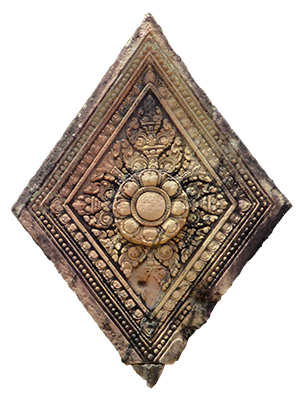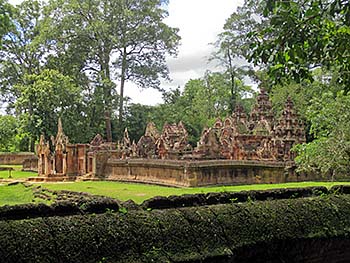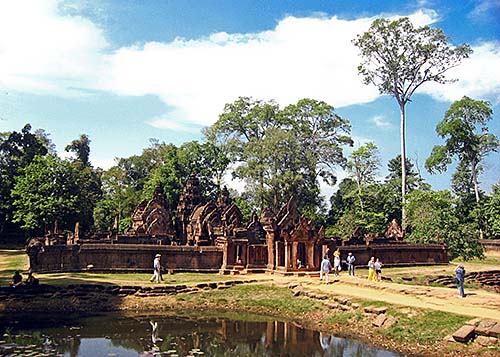
The Temple of Banteay Srei
Banteay Srei is an temple compound about 23km northeast of Angkor Wat in northwest Cambodia. It has been built in the mid 10th century and is one of the finest Angkorean temple sites. The buildings and gates are made from red sandstone, a particularly precious material which allows very filigree ornaments. The temple buildings are much smaller than most of the great temples nearby in and around Angkor Thom.
Banteay Srei

The temple compound of Banteay Srei, seen from outside the outer laterite wall (from northeast). Banteay Srei is a pearl of Angkorean architecture.
Between the laterite wall and the inner wall of the sanctuary is a moat surrounding the temples. Image by Asienreisender, 10/2015
Banteay Srei is the only Angkorean temple which was not built by a king but by two noblemen. The brothers and brahmans Yajnavaraha and Vishnukumara ordered the construction and dedicated it to the hindu god Shiva. The temple's original name was Tribhuvanamahesvara (great god of the threefold world). The contemporary name Banteay Srei was invited probably after the discovery of the compound in the Cambodian rainforest in 1914. It means 'citadel of beauty' or 'citadel of women'. There is speculation about the meaning of the name, but no clear answer. It might come from the many devatas (female spirits) who are carved into the walls. The completion of the temple compound fell into the reign of king Rajendravarman II. In the time when Banteay Srei was an active sanctuary, there was a town nearby.

The whole compound seen from southeast, inside the laterite wall. Image by Asienreisender, 12/2006
The construction was in the 20th century object of extensive lootings. The most prominent art theft was the French Andre Malraux, who was arrested when trying to bring four devatas from Banteay Srei to Paris for private purposes. After the Second World War Malraux, became culture minister in the government Charles de Gaulle.
A thorough restoration happened in the years 1931 - 36, undertaken by archaeologists from the École française d’Extrême-Orient. The restoration from 2004 on is financed with Swiss money.
The temple compound of Banteay Srei is placed on an artificial island. Access to the site is from a causeway which leads to the eastern entrance chamber. The main sanctuary consists of three prasats and two libraries. The inner temples are not open for visitors. The temples are enclosed by four rings of walls.
Photocomposition Banteay Srei

The approach to the temple complex leads via a long causeway from the eastern side. The causeway was in the past paralleled by a number of buildings, who where probably open for the public. Now there are only a few remains left of these buildings.
Angkor was a very hierarchically structured society. The inner part of the compound was reserved exclusively for elitarian members of the Angkorean society.
Those western women who like to stress the interpretation of the site's name as 'city of women' and see it as a dedication to or appreciation for women, mistaken the meaning. Banteay Srei wasn't the original name, and even this late derivation could rather be pronounced as Banteay Sri, 'auspicious city'. Angkor's culture was a male dominated warrior culture, dominated by high priests. All the handed down names of Angkorean history are male, mostly kings, priests, noblemen. Women played clearly an inferiour role in this society. In Angkorean depictions they appear mostly as temple dancers and concubines for the godkings. Compare that also with Zhou Daguan's record 'The Customs of Cambodia', which he wrote after a one-year stay in Angkor Thom as a member of a Chinese diplomatic delegation. It's even arguable if women were allowed to enter the inner temple compound of Banteay Srei.
The photocomposition gives an impression of the filigree work in the precious stone, which can rather be compared with woodwork than with stone carvings.
The bottom image shows the three prasats dedicated to the highest hindu gods. The central one is for Shiva, the southern one (right) for Vishnu and the northern one (left) for Brahma.
All images and photocomposition by Asienreisender, 10/2015